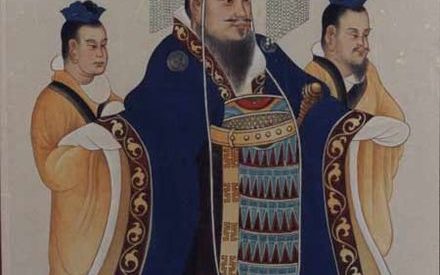A comparative study of the two great empires of antiquity
Introduction: The rise of Rome and Qin-Han
 Image Source: Locator map for the Roman Empire and the Chinese Han dynasty, c. AD 1. Wikipedia. Creative Commons Attribution-Share Alike 3.0 Unported license.
Image Source: Locator map for the Roman Empire and the Chinese Han dynasty, c. AD 1. Wikipedia. Creative Commons Attribution-Share Alike 3.0 Unported license.
The rise of the Roman Republic can in some ways be compared to the rise of the Qin state to prominence. Both were in the western margin of the civilized ecumene (the Greek states and the eastern Chinese states respectively) and were viewed as semi-barbaric. Their geographical position favored a focus on military capability. Both Rome and Qin were militaristic states. Both were able to develop thanks to being shielded by their geographical position from the great powers in the east. Eventually they were able to gain hegemonic power over a large sector of the ecumene, Italy for Rome and Sichuan for Qin. Then, in a series of high stake wars, Rome and Qin conquered their known ecumene. Qin was able to do so faster thanks to its protobureaucracy compared to the somewhat limited administrative capabilities of the oligarchic Roman state. In the first two centuries AD for Rome and from the second century BC to second century AD in China, the Roman and Han Empires focused on internal homogenization and slowed down their expansion.
The Bureaucratic Structure of Rome and Han Dynasty
Both Rome and Han China developed an elaborate administration to rule over their vast realms.
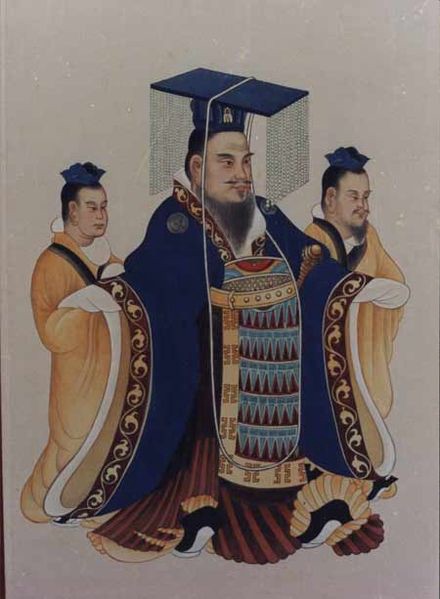 Image Source: Traditional portrait of Emperor Wu of Han. Wikipedia. Public Domain.
Image Source: Traditional portrait of Emperor Wu of Han. Wikipedia. Public Domain.
The Han Dynasty, ruling over 60 million people and a territory of 1.5 million square kilometers, was administered by a bureaucracy consisting of over 120,000 officials. The bureaucratic model of the Han Dynasty was modeled after that of the Western Zhou (1045?771 BC) and Qin (221?206 BC) Dynasties. The bureaucracy underwent many changes during the Han period, with some government agencies shrinking and other seeing their influence expanded. In 2 AD, the Han bureaucracy is estimated to have employed 120,285 officials. The Han Empire comprised of 1587 county-level governments.
At the head of this vast state machinery was the Emperor. Compared to the Roman Emperor, the Han Emperor was much more passive and ritualistic. The emperor was connected with the government bodies via the Inner Courtand Outer Court. The Inner Court had six masters: master of clothing, master of food, master of headgear, master of banquets, master of baths, and master of writing. The first five were responsible for the daily life of the emperor and were usually filled by eunuchs. The master of writing was the emperor?s secretary. The Inner Court was also filled with a large number of officials who had no administrative duties but held honorific titles. The Inner Court was administered by two Outer Court ministries: the superintendent of the imperial clan and the privy treasurer.
The Outer Court would also administer the whole country instead of dealing only with the Emperor?s private affairs like the Inner Court did. The Outer Court was headed by three excellencies (san gong): chancellor, supreme commandant and imperial counselor. They were responsible respectively for government administration, military a?airs, and the censorial branch of the bureaucracy. Unlike the Roman Empire, in which military officers played a crucial role, the Han Empire was dominated by civilian officials and generals had officially little legitimate role in domestic affairs. The officials responsible for military affairs were civilian.
The Chancellor had beneath him thirteen bureaus (cao): West Bureau and East Bureau [both responsible for promotions and demotion of officials), Bureau of Imperial Household, Bureau of Memorials, Bureau of Litigation, Bureau of Communication and Standards, Bureau of Military Transportation, Bureau of Bandit Control, Bureau of Criminal Executions, Bureau of Soldiers, Bureau of Granaries, Bureau of Yellow Cabinet [maintenance of state records] and Bureau of Gold.
Commanderies were headed by a grand governor (tai shou), who took charge of all the civilian and military a?airs in his commandery as well as administering the criminal law. He was assisted by lower officials, such as clerks and assistants. County-level governance had a similar structure.
Roman and Han Economies
Both the Roman and Han economies were in large part based on agriculture. The Roman organization of the economy was unprecedented for the Mediterranean world as it made much more extensive use of slave labor than past imperial regimes. Roman agriculture was centered on large plantations called latifundia that were worked by hundreds of slaves. Their products were then sold in urban markets. The crops were different in each region: olive oil in North Africa and Spain, wheat in Egypt and vineyards in Gaul.
The Romans made extensive investments into building up good infrastructure, constructing an extensive road network. They also facilitated the monetization of the economy by producing massive amounts of coinage. Trade was also influential in the Roman economy. The road network facilitated it and so did the Mediterranean, which made it easy to shuttle goods throughout the Empire through sea. Sea trade was less expensive than land trade and the fact that Rome was more of a naval empire than the Han Dynasty meant that commerce played a greater role in the Roman economy.
The Han Dynasty, unlike the Romans, relied on free labor rather than slaves for agriculture. Instead of using slave labor, Chinese landowners would use contracts and money to strike bargains with laborers. The free farmers were in large part self-sufficient and would produce goods that were in demand. Much like the Romans, the Han Dynasty also issued large quantities of coinage but since China lacked silver, bronze coins were the basis of the monetary economy. The Chinese also built large scale road networks to facilitate commerce and after defeating the Xiongnu in the West, they were able to begin trade with Persia and, indirectly, with Rome.
Crisis and Fragmentation
Both Empires eventually faced problems with barbarians invaders. In the case of China, it was the Xiongnu, a confederation of nomadic steppe peoples. In the case of Rome, it was the Germanic tribes beyond the Rhine and Danube that caused the most problems. Rome also, unlike the Han Dynasty, faced the unique problem of the Sassanid Dynasty, a highly developed centralized imperial state. Those challenges had effects on both Empires.
 Image Source: Three Kingdoms in 262, on the eve of the conquest of Shu, Wei and Wu. Wikipedia. Creative Commons Attribution-Share Alike 3.0 Unported license.
Image Source: Three Kingdoms in 262, on the eve of the conquest of Shu, Wei and Wu. Wikipedia. Creative Commons Attribution-Share Alike 3.0 Unported license.
In China, the mass levied armies of the Qin and other Warring State period states were abandoned in favor of professional soldiers drawn from lowest strata of the Chinese population and cavalry hired from the steppe tribes, as the mass military of the earlier period was not suited to the highly mobile Xiongnu. That system was highly successful at eventually defeating the Xiongnu but it created new problems for Han China. Unlike the legionaries of Rome, armies of barbarians and convicts had little loyalty to the state. Once the danger of Xiongnu passed, the imperial court stopped paying subsidies to its barbarian allies and they turned into plunder. A new enemy emerged, this time from the West: the Qiang. The decision by the court of establishing colonies of Chinese in the Western border regions foundered on the difficulties of maintaining agricultural communities in the arid west. Ultimately, the central government lost control of the western frontier, as provincial governors began taking matters on their own hands and in effect created private armies. This contributed to the collapse of the dynasty. The empire also faced internal problems as there was a succession of incompetent emperors who relied too much on court eunuchs and mismanaged the empire. The Yellow Turban rebellion (184?205 AD) allowed provincial governors to establish their independence. This accelerated the collapse of the central government that led to the division of China. Eventually, three kingdoms emerged; Wei, Shu Han and Wu. The Wei state emerged as the most powerful of the three and came under the control of the Sima family that established the Jin Dynasty (266) that would reunify China by 280.
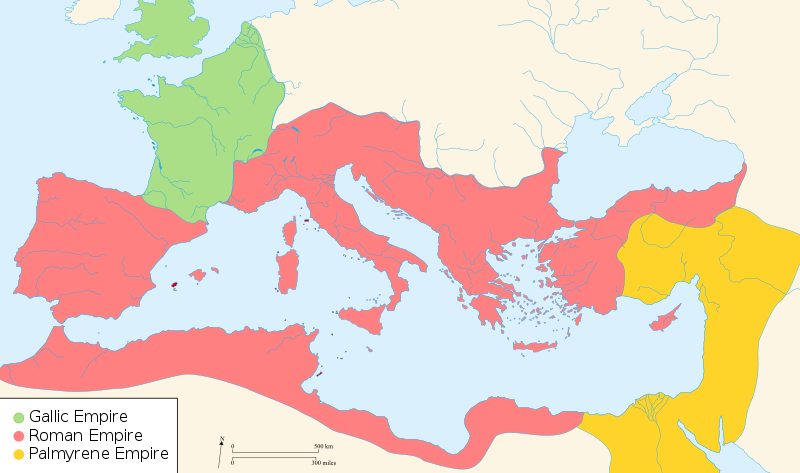 Image Source: Map of the Roman Empire around the year of the consulship of Aurelianus and Bassus (271 AD), with the break away Gallic Empire in the West and the Palmyrene Empire in the East. Wikipedia. GNU Free Documentation License
Image Source: Map of the Roman Empire around the year of the consulship of Aurelianus and Bassus (271 AD), with the break away Gallic Empire in the West and the Palmyrene Empire in the East. Wikipedia. GNU Free Documentation License
Rome had a standing professional army since the time of the Republic thanks to the reforms of Gaius Marius (157?86 BC). In the later decades of the second century and during the third century, Rome faced a multitude of problems. Rome faced enemies on many fronts; Rhine, Danube, Britain and the East. So when Rome was occupied on one front, it allowed enemies to take advantage of the situation. The Romans also faced the Sassanid Dynasty that more than once defeated the Romans in battle and even captured Emperor Valerian. Although in the first and second centuries, for the most part, Emperors were able to pass power on to their successors peacefully, in the third century a multitude of emperors, rebels, and pretenders competed for the throne and civil wars shook the Empire. The breakdown of imperial order meant that provinces had to assume responsibility for their defense and this led to insurrections in the 260s and 270s that threatened the unity of the Empire. The Gallic Empire in the West and the Palmyrene Empire in the East emerged. Thus the Roman Empire was divided in three, much like the Han Dynasty. Unlike the Three Kingdoms, however, the Roman central government was better able to face the crisis and eventually reasserted central control over the Empire. The man who reunified Rome was Emperor Aurelian (270?275). With a series of campaigns he restored imperial unity and earned the title of Restitutor Orbis (Restorer of the World). In 284, Diocletian came to the imperial throne and instituted a series of reforms. He divided the Empire into two administrative parts that would allow it to better face the multiple enemies, increased the size of the military and expanded the imperial bureaucracy in order to collect the taxation necessary for the expanded military.
Collapse and Survival
Both the resurgent Roman Empire and the Jin Dynasty proved to be ephemeral. Although they restored unity, the pressure of barbarian invaders and internal infighting would cause the loss of the heartland of both Empires (Italy and the West in the case of Rome, northern China in the case of Jin). However, both Empires would manage to survive; Eastern Rome (Byzantium) in the East and Jin in the South.
 Image Source: The Jin Empire at its greatest extent, c. 280. Wikipedia. Creative Commons Attribution-Share Alike 3.0 Unported license.
Image Source: The Jin Empire at its greatest extent, c. 280. Wikipedia. Creative Commons Attribution-Share Alike 3.0 Unported license.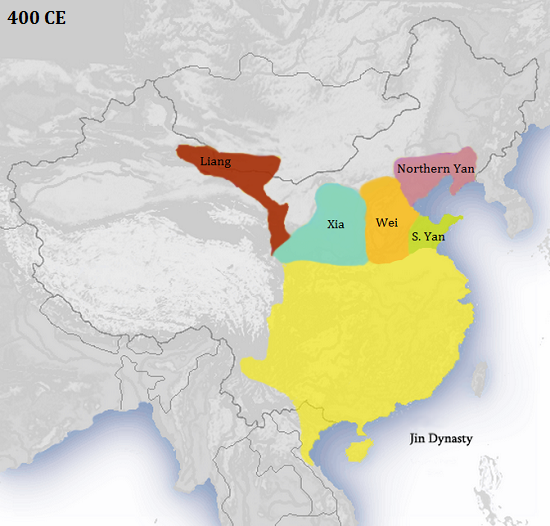 Image Source: Map of China c.400 CE/AD. Wikipedia. Creative Commons Attribution-Share Alike 3.0 Unported license.
Image Source: Map of China c.400 CE/AD. Wikipedia. Creative Commons Attribution-Share Alike 3.0 Unported license.
The Jin Dynasty was able to foster a period of prosperity from 280 to 304 AD. The Empire lowered taxes and subsidized public works. The decline of the dynasty can be attributed to decisions made by Emperor Wu; he appointed many of his brothers and sons as Kings of individual provinces, weakening greatly the central government. His successor, Emperor Hui, had to fight with regional princes in civil wars that further weakened Jin. Barbarians tribes (called Wu Hu) in northern China, taking advantage of the infighting and chaos, revolted against the Jin in 304 led by a Liu Yuan. This is known as ?Uprising of the Five Barbarians? ? ?Five Barbarians throw China into disorder?. The Jin capitals of Luoyang and Chang?an were captured and the Jin remnants retreated to the South.
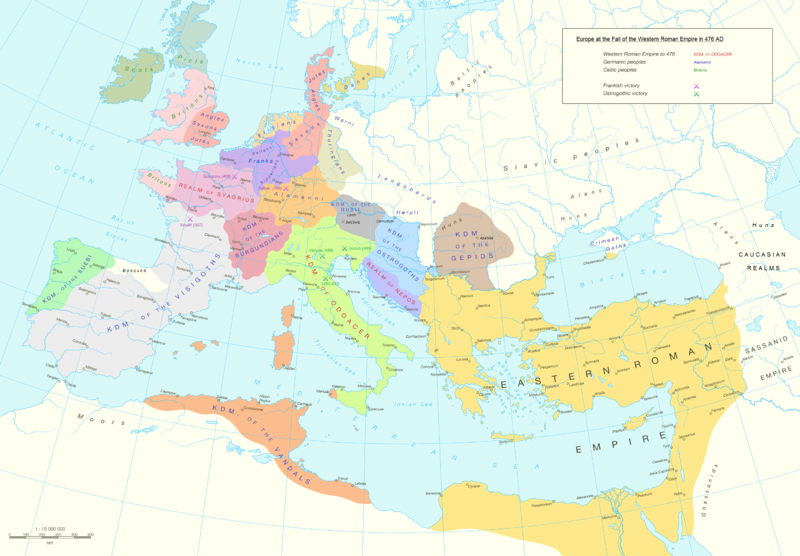 Image Source: Political division in Europe, North Africa and Near East after the end of the Western Roman Empire in 476 AD. Wikipedia. Creative Commons Attribution-Share Alike 4.0 International license.
Image Source: Political division in Europe, North Africa and Near East after the end of the Western Roman Empire in 476 AD. Wikipedia. Creative Commons Attribution-Share Alike 4.0 International license.
A similar development took place in the Roman Empire. Under Diocletian and Constantine, the Empire made a dynamic comeback. However, Constantine?s successors fought among themselves in civil wars. Although under Julian the Apostate such fighting temporarily ceased, his Persian campaign proved to be a defeat and he lost his life. Valens and Valentinian restored stability to the Empire but the defeat of the Eastern army under Valens at the Battle of Adrianople (378) and the civil wars in the West deteriorated the situation in the Empire. While Theodosius the Great was able to once again restore a sense of stability and reunify the Empire, after his death in 395 the Empire was divided again in two. Once again, the two parts of the Empire clashed due to the ambitions of Stilicho, magister militum of the West. Although good relations were restored after his death, this weakened the already less rich and powerful West. The Western Empire had more than a few disadvantages.
- The West was less urbanized and rich than the Roman East. As such, it fared less well on its own, in contrast to the East.
- Western landlords held far more land than their Eastern counterparts and were able to subvert imperial authority. The richest Senators of the East had relatively modest riches and land compared to Western Senators.
- Unlike their Eastern counterparts, Western emperors (especially in the fifth century) did not enjoy long reigns and this created instability and delegitimized the government and office of Emperor.
- The Western Empire came to be dominated by military officers who subverted the office of Emperor and were often of barbarian origins. In the East, it were palace eunuchs, civil officials and princesses that came to dominate and those groups had to rely on the office of Emperor.
- The Western military was increasingly barbarized. This was a problem for the East too, but unlike their Eastern counterparts, the Western Romans were unable to get rid of the barbarians. While Emperor Leo I (457?474) was able to eliminate the threat of the barbarian general Aspar and his Germanic warriors with the help of the Isaurians, the Western emperor Majorian (457?461) was murdered by the barbarian Ricimer.
- The East was able to direct groups of barbarians (such as Attila and his Hunnic hordes) to the West. This allowed the East to survive but greatly affected the West. The West also suffered the most from Germanic invasions from over the Rhine. As it lost territories to barbarians, it also lost income from those provinces and the ability to recruit troops to defend the remaining territories of the Empire.
Eventually the Roman West fell under barbarian control while the Roman East managed to survive.
Imperial Restoration: Justinian and Charlemagne ? Sui Dynasty
The Eastern Roman (Byzantine) Empire made in the sixth century an ultimately unsuccessful attempt at reuniting the Roman World. Charlemagne in 800 restored the Western Roman Empire. Yet both failed to reunify the Roman world. In China, the Sui Dynasty restored unity to the Chinese world.
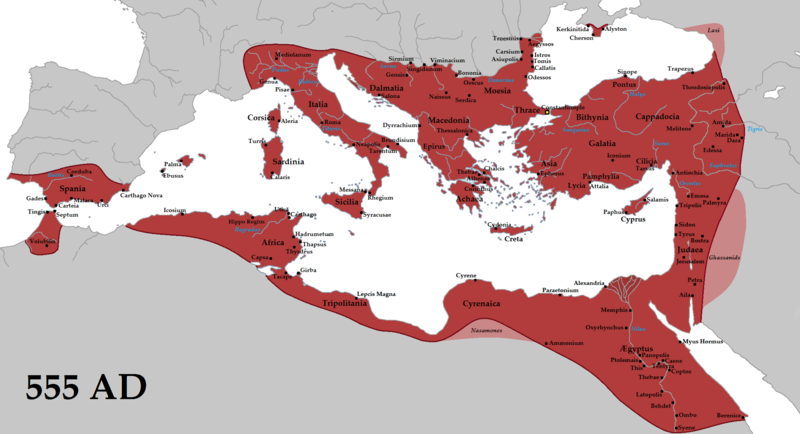 Image Source: The Eastern Roman Empire (red) and its vassals (pink) in 555 AD during the reign of Justinian I. Wikipedia. Creative Commons Attribution-Share Alike 3.0 Unported license.
Image Source: The Eastern Roman Empire (red) and its vassals (pink) in 555 AD during the reign of Justinian I. Wikipedia. Creative Commons Attribution-Share Alike 3.0 Unported license.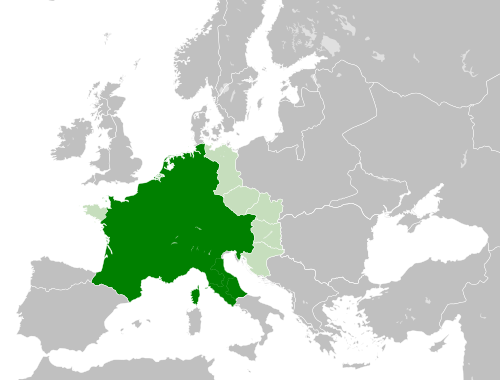 Image Source: Francia at its greatest extent in 814. Wikipedia. Creative Commons Attribution-Share Alike 4.0 International license.
Image Source: Francia at its greatest extent in 814. Wikipedia. Creative Commons Attribution-Share Alike 4.0 International license.
The Eastern Roman Empire in the sixth century launched a series of military invasions with the goal of restoring, at least partly, the Roman Empire. Justinian (527?565) sent capable generals (Belisarius, Liberius and Narses) to retake the territories of North Africa, Italy and parts of Spain. Despite the success of Roman arms and the fact that new provinces were not unprofitable, the Empire declined for several reasons:
- The Justinianic Plague (first reported in 541) killed hundreds of thousands of civilians, disrupted economic activities and had severe effects on both the economy and urban life.
- The plague and the decline in urbanization, as well as Justinian?s somewhat excessive spending (although this factor often gets exaggerated), caused problems with imperial finances and the payment of troops. It should be noted that Emperor Maurice (582?602) was overthrown by his soldiers because, in an attempt to save money, he ordered them to remain north of Danube during winter.
- Civil wars and internal instability (first with the usurpation of throne by Phocas and then with the civil war between Phocas and Heraclius) weakened the Empire and allowed its enemies to exploit its weakness (Slavs and Avars in Balkans and Persians in Middle East).
Thus in the seventh century, the Empire almost collapsed as it lost most of the Balkans to the Slavs and Syria, Levant, Egypt and North Africa to the Arabs. The Byzantines were able to stop the Arab onslaught and made a comeback, becoming the richest and most powerful European state from the tenth century until at least the twelfth century. However, it stood no chance of restoring Roman control over the ecumene.
The Franks in the West, who during the collapse of the Western Roman Empire had established themselves in Gaul, were able to expand their holdings and under Charlemagne they united most of Western Europe. During the eighth and ninth centuries, Byzantium was mired by internal conflict over the Christian icons (Iconoclast Emperors considered them a form of idolatry, putting them at odds with the Pope). They also were too focused on the Arab onslaught and the Bulgar threat in the Balkans to aid the Pope and the imperial holdings in Italy that were under the threat of the Lombards. The Franks were closer to Italy and proved that they could protect the Pope and intervene effectively in Italy. Hence the Pope turned to Charlemagne for assistance
In Christmas 800, Charlemagne was crowned by the Pope in Rome Emperor, a title reserved for the Roman monarch. The Pope justified this with the excuse that since a woman (Irene) was holding the throne in Constantinople, the Roman throne was vacant. It is said that Charlemagne was in negotiations with Empress Irene for a possible marriage agreement that would unite the two Empires. This never materialized since Empress Irene was overthrown in a palace coup that brought Nicephorus I to the throne. The Franks were not powerful enough to conquer Byzantium and thus the division of the ecumene was retained.
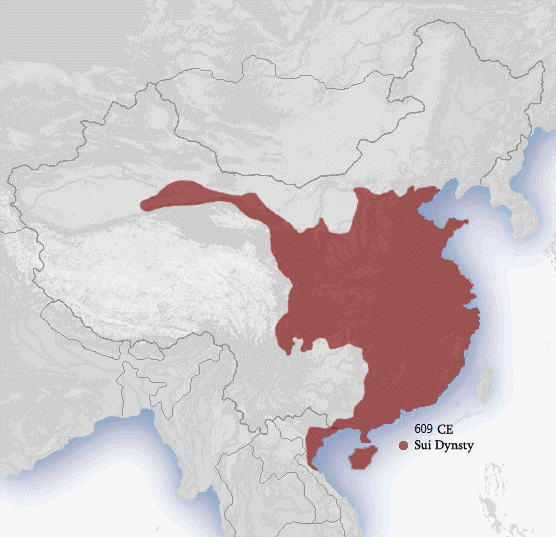 Image Source: Sui dynasty c.609. Wikipedia. Creative Commons Attribution-Share Alike 3.0 Unported license.
Image Source: Sui dynasty c.609. Wikipedia. Creative Commons Attribution-Share Alike 3.0 Unported license.
In China, the situation was different. In northern and southern China, a series of (barbarian in the north, native in the south) dynasties succeeded one another in quick succession. Eventually, the Northern Zhou dynasty was able to reunify the north. Yang Jian (Emperor Wen) seized the throne from Emperor Jing of Northern Zhou in 581, establishing the Sui Dynasty. In 589, the Sui Dynasty took over the southern Chen Dynasty and restored unity in the Chinese ecumene. The Western equivalent would have been if Charlemagne had conquered Byzantium and restored unity over the Roman world.
That unification of the Sui Dynasty was short-lived but set the stage for a more durable unification under the Tang Dynasty. While the Sui founder Emperor Wen (581?604) was a capable ruler, his successor Emperor Yang spent too much money on vast infrastructure projects and pursued an expansion foreign policy, which most disastrously failed in Korea as his invasions were unsuccessful and led to a weakening of the central government and revolts.
Li Yuan, founder of the Tang Dynasty, was a garrison commander in Taiyuan when revolt against the Sui broke out in 613. He marched to the Sui capital in 617 and founded the Tang Dynasty after forcing the abdication of the last Sui Emperor, Yang You. The new dynasty initially ruled only Guanzhong while the northeast, the central plain, and the south were still under the control of rival warlords who had command over hundreds of thousands of troops. It took five years of campaigning by the imperial princes Li Jiancheng and Li Shimin before the country was reunified.
For the next three centuries China would be under the control of an empire comparable with that of the Han Dynasty. The Tang Dynasty was among the richest and most powerful states in the medieval world. On the other hand, Byzantium and the Holy Roman Empire would remain unable to assert control over the whole old Roman world.
Summarization
The Roman and Han Empires were vast realms kept under control by vast state machinery (for the standards of the age) and ruling over a large part of their respective ecumene. They had developed economies, relying mainly on agriculture and on commerce.
The Roman Empire and the Han Dynasty faced similar problems of barbarian invasions and internal infighting. The Han Dynasty collapsed and gave way to Three Kingdoms while Rome faced a series of civil wars and insurrections. Eventually, Aurelian, Diocletian and Constantine restored unity to the Roman world while the Jin Dynasty reunified China. This imperial comeback was, however, short-lived in both cases.
To contrast the Eastern Roman Empire to its Western counterpart, the East had numerous advantages (economic, institutional and military) that allowed it to survive the fall of the West. This can partly be compared to the southern Jin that managed to survive fall of northern China to barbarian tribes. Neither Byzantium nor Jin could reconquer the lost parts of the Empire (although, under Justinian, the Byzantines came pretty close to it).
Whereas under the Sui unity was restored in the Chinese ecumene, neither Justinian nor the Frankish Empire under Charlemagne were able to achieve this in the West. Nevertheless, the Byzantines were able to survive until the 15th century as an independent entity while the Holy Roman Empire would survive as an entity until 1806, when Napoleon forced its dissolution. The Chinese Empire would survive as an institution up to 1911. While China today remains a unified entity, the Roman world remains fractured among European nation-states and Arab nation-states in West Asia and North Africa.
